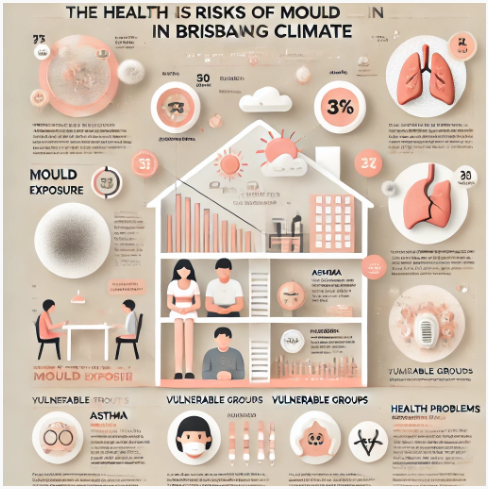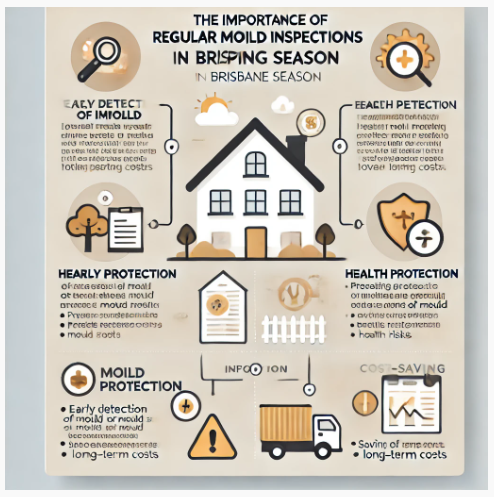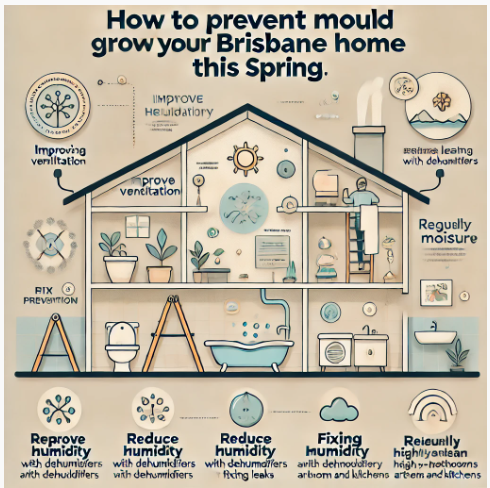The Health Risks of Mould Exposure in Brisbane’s Spring Climate
Mould is more than just an unsightly issue in the home. It poses real health risks, particularly in Brisbane’s spring climate, where increased warmth and humidity create ideal conditions for mould to thrive. Left untreated, mould can significantly affect the health of everyone in the home, especially those with respiratory conditions or weakened immune systems.
This article explores the health dangers of mould exposure, the groups most at risk, and why mould growth becomes more dangerous during Brisbane’s spring season.
How Mould Affects Health
Mould releases spores into the air as it grows. These spores contain allergens and irritants that can negatively affect indoor air quality and lead to health problems. When inhaled, mould spores can cause reactions ranging from mild allergic symptoms to more serious respiratory issues.
According to Queensland Health, mould can trigger a wide range of health problems, including:
- Allergic reactions: Symptoms may include sneezing, runny nose, red eyes, and skin irritation.
- Asthma attacks: Mould is a well-known asthma trigger, particularly in children.
- Respiratory infections: Prolonged exposure to mould can cause infections in people with weakened immune systems or pre-existing respiratory conditions.
- Irritation of the eyes, nose, and throat: Mould spores can irritate the mucous membranes, leading to discomfort and inflammation.
Why Mould Growth Increases in Spring
Brisbane’s spring weather provides the ideal environment for mould to thrive. The combination of higher temperatures, increased rainfall, and high humidity levels creates conditions that allow mould to grow rapidly indoors.
Statistics from the Australian Bureau of Meteorology show that Brisbane’s spring humidity levels can reach up to 70%, which promotes moisture buildup inside homes. Mould can grow on almost any surface, including walls, ceilings, carpets, and even furniture. Once mould takes hold, it can release spores into the air, worsening the indoor air quality and increasing the risk of health issues.
Vulnerable Groups Affected by Mould
While anyone can be affected by mould exposure, certain groups are more vulnerable. These include:
- Children: Children, especially those under the age of 12, are more sensitive to allergens in the air. According to Asthma Australia, up to 80% of children with asthma are allergic to mould. Mould exposure can trigger asthma attacks and worsen symptoms.
- The Elderly: Older adults may have weaker immune systems, making them more susceptible to respiratory infections caused by mould exposure. A study from the Australian Institute of Health and Welfare showed that respiratory conditions are one of the leading causes of hospital admissions among older Australians.
- People with asthma or respiratory conditions: Mould is a known trigger for asthma, and exposure can lead to severe attacks. The National Asthma Council of Australia reports that mould is one of the most common indoor triggers for asthma. People with pre-existing respiratory conditions, such as chronic obstructive pulmonary disease (COPD), are also at a higher risk of complications from mould exposure.
- Immunocompromised individuals: People with weakened immune systems, including those undergoing cancer treatment or living with conditions such as HIV, are particularly vulnerable to mould-related infections. Queensland Health warns that mould exposure in immunocompromised individuals can lead to serious fungal infections, which may require hospitalisation.
The Long-Term Health Effects of Mould Exposure
The health effects of mould exposure are not limited to short-term symptoms. Long-term exposure to mould can lead to chronic health problems, especially if the mould is not properly removed from the home.
1. Chronic Respiratory Issues
Prolonged exposure to mould can lead to long-term respiratory issues, even in people who do not have pre-existing conditions. Studies published by the World Health Organization (WHO) have shown that long-term exposure to mould can contribute to the development of asthma in both children and adults. Mould exposure is also linked to chronic bronchitis and other respiratory conditions.
2. Weakened Immune System
Over time, exposure to mould can weaken the immune system, making it harder for the body to fight off infections. This is especially dangerous for people who already have weakened immune systems. A CSIRO study found that homes with poor indoor air quality, including those with high levels of mould, have a higher incidence of illnesses such as colds, flu, and other respiratory infections.
3. Mental Health Effects
Living in a mould-infested environment can also impact mental health. The stress of dealing with persistent mould problems, coupled with the physical symptoms of mould exposure, can contribute to anxiety and depression. A study by the Environmental Health Perspectives Journal found that people living in homes with mould reported higher levels of mental distress compared to those in mould-free environments.
Brisbane’s Spring Climate and Its Impact on Mould Growth
Spring in Brisbane is a time when mould growth accelerates due to the combination of heat and moisture. The average humidity in Brisbane during spring can exceed 70%, and with frequent rainfall, homes are at higher risk of developing moisture-related issues.
Leaky roofs, clogged gutters, and condensation from indoor activities like cooking and showering can all contribute to mould growth. In some cases, homeowners may not even realise they have a mould problem until it becomes severe. Mould can grow behind walls, under carpets, and in poorly ventilated areas, making it difficult to detect without a professional inspection.
According to Mould.org.au, homes in tropical and subtropical climates, like Brisbane, are at a higher risk of mould problems year-round, but the risk peaks in spring due to the weather conditions.
The Importance of Professional Mould Removal
While some homeowners may attempt to clean mould themselves, DIY methods are often ineffective and can make the problem worse. Using bleach or household cleaners may remove visible mould but fail to address the root cause or eliminate spores that are circulating in the air.
Professional mould removal services, like those offered by Reliance Mould Solutions, are essential for thorough and safe removal. Professional mould specialists use advanced equipment and techniques to:
- Detect hidden mould: Using moisture metres and infrared cameras, professionals can identify areas of mould growth that may not be visible to the naked eye.
- Improve indoor air quality: Professional mould removal includes air purification techniques that capture mould spores in the air, improving the overall indoor air quality.
- Prevent future growth: After removing mould, professionals apply treatments that help prevent mould from returning. This often includes addressing moisture sources, improving ventilation, and using specialised sealants.
How to Protect Your Home and Health During Spring
Given the increased risk of mould growth in Brisbane’s spring climate, there are steps homeowners can take to reduce the likelihood of mould developing and affecting health:
- Improve ventilation: Ensure proper airflow in high-moisture areas like kitchens, bathrooms, and basements. Installing exhaust fans and opening windows can help reduce humidity.
- Fix leaks promptly: Leaks in roofs, windows, and plumbing should be repaired immediately to prevent moisture buildup.
- Use dehumidifiers: In humid climates like Brisbane, using dehumidifiers can help maintain indoor humidity levels below 60%, making it harder for mould to grow.
- Schedule regular inspections: Professional mould inspections, especially in spring, can help identify early signs of mould growth and prevent larger infestations.
Protect Your Health from Mould in Spring
Mould growth in Brisbane is a serious health risk, particularly during spring when warmth and humidity allow mould to thrive. Vulnerable groups, such as children, the elderly, and those with respiratory conditions, are especially at risk of health complications from mould exposure. The long-term effects of mould exposure can be severe, but regular inspections and professional removal services can prevent these issues from escalating.
At Reliance Mould Solutions, we provide comprehensive mould inspection and removal services to help Brisbane homeowners protect their health and homes. Contact us today to schedule an inspection and keep your home mould-free this spring.
Please see our article on How to Prevent Mould Growth in Brisbane



